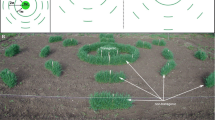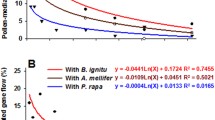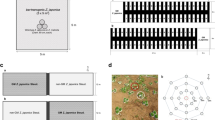Abstract
One of the most pressing issues surrounding transgenic oilseed rape cultivation is the potential impact of GM genes entering neighboring non-GM oilseed rape plants, related weeds or closely related wild relatives. Following the principle of a case-by-case for transgenic crop safety assessment, we designed experiments to study pollen-mediated gene flow from herbicide-resistant transgenic oilseed rape to Chinese commercial varieties. The pollen dispersal was detected as the progeny of recipient plants that were identified as glufosinate resistant. The results indicated that pollen dispersal occurred up to 2000 m and its rate sharply decreased as the distance from the pollen source increased. However, the rate of long-distance pollen dispersal from 33 to 2000 m was less than 0.015% and did not present a gradual decrease, indicating the randomization of dispersal and pollination. Most pollen dispersed within a 4.5 m area around the transgenic pollen source plot, with a maximum of 1.19% at the sampling site of 1.4 m. Wind direction significantly affected the direction and the distance of pollen dispersal, resulting in the more and farther dispersal in southwest direction. However, the number of potentially pollinating bees was not correlated with direction and distance from the pollen source plot, suggesting that bee density and distribution would not contribute to the differences in pollen dispersal among different directions. This paper is the first report on research in a large-scale experiment of pollen-mediated gene flow under the China’s environmental conditions and provided scientific evidence for the effective commercialization of transgenic oilseed rape and its safe management. Our results also provided important data on pollen spatial distribution pattern.
Similar content being viewed by others
References
Fulton M, Keyowski L. The producer benefits of herbicide-resistant canola. AgBioForum, 1999, 2: 85–93
Zhao X X, Lu W P, Qi C K, et al. Assessment on alien herbicide-resistant gene flow among crucifers by sexual compatibility. Chin Sci Bull, 2005, 50: 1604–1611
Allainguillaume J, Alexander M, Bullock J M, et al. Fitness of hybrids between rapeseed (Brassica napus) and wild Brassica rapa in natural habitats. Mol Ecol, 2006, 15: 1175–1184
FitzJohn R G, Armstrong T T, Newstrom-Lloyd L E, et al. Hybridisation within Brassica and allied genera: Evaluation of potential for transgene escape. Euphytica, 2007, 158: 209–230
Beckie H J, Warwick S I, Nair H, et al. Gene flow in commercial fields of herbicide-resistant canola (Brassica napus). Ecol Appl, 2003, 13: 1276–1294
Hüsken A, Dietz-Pfeilstetter A. Pollen-mediated intraspecific gene flow from herbicide resistant oilseed rape (Brassica napus L.). Transgenic Res, 2007, 16: 557–569
Scheffler J A, Parkinson R, Dale P J. Frequency and distance of pollen dispersal from transgenic oilseed rape (Brassica napus). Transgenic Res, 1993, 2: 356–364
Walklate P J, Hunt J C R, Higson H L, et al. A model of pollen-mediated gene flow for oilseed rape. P Roy Soc B-Biol Sci, 2004, 271: 441–449
Cresswell J E. The influence of nectar and pollen availability on pollen transfer by individual flowers of oilseed rape (Brassica napus) when pollinated by bumblebees (Bombus lapidarius). J Ecol, 1999, 87: 670–677
Ramsey G, Thompson C, Squire G. Quantifying landscape-scale gene flow in oilseed rape. Final Report of DEFRA Project RG0216, An experimental and mathematical study of the local and regional scale movement of an oilseed rape transgene. 2003
Timmons A M, O’Brien E T, Charters Y M, et al. Assessing the risks of wind pollination from fields of genetically modified Brassica napus ssp. oleifera. Euphytica, 1995, 85: 417–423
Simpson E C, Norris C E, Law J R, et al. Gene flow in genetically modified herbicide tolerant oilseed rape (Brassica napus) in the UK. In: Lutman P J W, ed. Gene Flow and Agriculture-relevance for Transgenic Crops. Staffordshire: BCPC/University of Keele, 1999, 72: 75–81
Hoyle M, Cresswell J E. The effect of wind direction on cross-pollination in wind-pollinated GM crops. Ecol Appl, 2007, 17: 1234–1243
Kuparinen A, Schurr F, Tackenberg O, et al. Air-mediated pollen flow from genetically modified to conventional crops. Ecol Appl, 2007, 17: 431–440
Stringham G R, Downey R K. Effectiveness of isolation distance in seed production of rapeseed (Brassica napus). Agron Abstr, 1982, 136–137
Rieger M A, Lamond M, Preston C, et al. Pollen-mediated movement of herbicide resistance between commercial canola fields. Science, 2002, 296: 2386–2388
Ingram J. Report on the separation distances required to ensure cross-pollination is below specified limits in non-seed crops of sugar beet, maize, and oilseed rape. MAFF report RG0123. London: MAFF. 2000
Lavigne C, Klein E K, Vallee P, et al. A pollen dispersal experiment with transgenic oilseed rape. Estimation of the average pollen dispersal of an individual plant within a field. Theor Appl Genet, 1998, 96: 886–896
Baker J, Preston C. Predicting the spread of herbicide resistance in Australian canola fields. Transgenic Res, 2003, 12: 731–737
Weekes R, Deppe C, Allnutt T, et al. Crop-to-crop gene flow using farm scale sites of oilseed rape (Brassica napus) in the UK. Transgenic Res, 2005, 14: 749–759
Devaux C, Lavigne C, Austerlitz F, et al. Modelling and estimating pollen movement in oilseed rape (Brassica napus) at the landscape scale using genetic markers. Mol Ecol, 2007, 16: 487–499
Wang D P. Current status and future strategies for development of transgenic plants in China. J Integr Plant Biol, 2007, 49: 1281–1283
Liu H L. Inheritance and breeding of oilseed rape (Brassica napus) (in Chinese). Shanghai: Shanghai Technology Publishing House, 1984
Wu Y R. Insecta vol. 20 Hymenoptera: Melittidae and Apidae (in Chinese). Beijing: Science Press, 2000
Jiang C, Chen Y. A method of isolation genomic DNA from Brassica. Chin J Oil Crop Sci, 1995, 17: 34–36
Manasse R S. Ecological risks of transgenic plants: Effects of spatial dispersion on gene flow. Ecol Appl, 1992, 2: 431–438
Morris W F, Kareiva P M, Raymer P L. Do barren zones and pollen traps reduce gene escape from transgenic crops? Ecol Appl, 1994, 4: 157–165
Hommel B, Pallutt B. Evaluation of transgenic herbicide-resistant oilseed rape and maize with reference to integrated pest management strategies. The BCPC international Congress: Crop Science and Technology, 2003. 1087–1092
Eastham K, Sweet J. Genetically modified organisms (GMOs): The significance of gene flow through pollen transfer. Environmental Issue Report Number 28, European Environment Agency, Copenhagen, Denmark. 2002
Downey R K. Gene flow and rape — the Canadian experience. In: Lutman P J W, ed. Gene Flow and Agriculture-relevance for Transgenic Crops. Staffordshire: BCPC/University of Keele, 1999, 72: 109–116
Thompson C E, Squire G, Mackay G R, et al. Regional patterns of gene flow and its consequences for GM oilseed rape. In: Lutman P J W, ed. Gene Flow and Agriculture-relevance for Transgenic Crops. Staffordshire: BCPC/University of Keele, 1999, 72: 233–240
Cresswell J E. A method for quantifying the gene flow that results from a single bumblebee visit using transgenic oilseed rape Brassica napus L. cv. Westar. Transgenic Res, 1994, 3: 134–137
Funk T, Wenzel G, Schwarz G. Outcrossing frequencies and distribution of transgenic oilseed rape (Brassica napus L.) in the nearest neighbourhood. Eur J Agron, 2006, 24: 26–34
Pierre J. The role of honeybees (Apis mellifera) and other insect pollinators in gene flow between oilseed rape (Brassica napus) and wild radish (Raphanus raphanistrum). Acta Hortic, 2001, 561: 47–51
Damgaar C, Kjellsson G. Gene flow of oilseed rape (Brassica napus) according to isolation distance and buffer zone. Agric Ecosyst Environ, 2005, 108: 291–301
Scientific Committee on Plants. Opinion of the scientific committee on plants concerning the adventitious presence of GM seeds in conventional seeds. SCP/GMO-SEEDCONT/002-final 13 March 2001
Gliddon C, Boudry P, Walker S. Gene flow-a review of experimental evidence. In: Gray A J, Amijee F, Gliddon C J, eds. Environmental Impact of Genetically Modified Crops. London: DETR, 1999. 65–79
Author information
Authors and Affiliations
Corresponding author
Additional information
Supported by Bayer (China) Co. Ltd. and Division of GM Biosafety Management, the Ministry of Agriculture, China
About this article
Cite this article
Cai, L., Zhou, B., Guo, X. et al. Pollen-mediated gene flow in Chinese commercial fields of glufosinate-resistant canola (Brassica napus). Chin. Sci. Bull. 53, 2333–2341 (2008). https://doi.org/10.1007/s11434-008-0305-6
Received:
Accepted:
Published:
Issue Date:
DOI: https://doi.org/10.1007/s11434-008-0305-6




